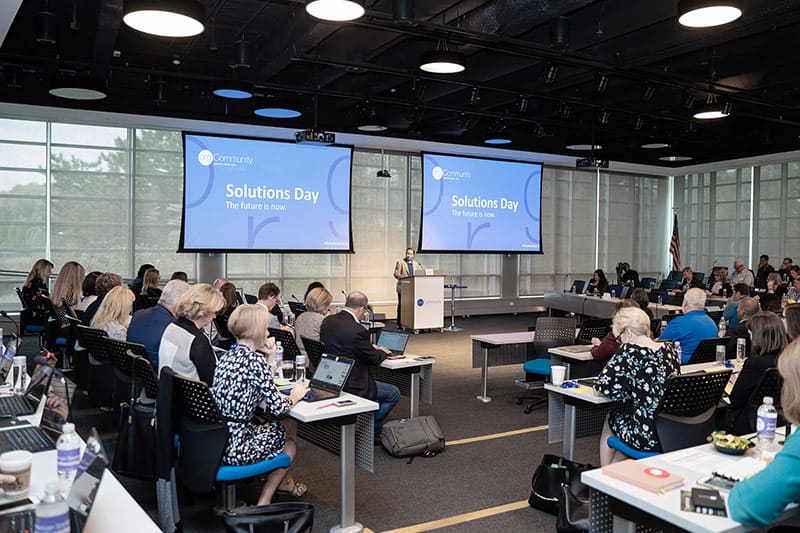
If a girl scout in your house is selling cookies, who are the top prospects on her list? That’s a no-brainer. Even friends who have sworn off sugar will probably say yes to a box of Thin Mints from your fledgling entrepreneur.
An emotional connection paves the way for an easy sale. That advice is increasingly important for associations. New generations of members want you to meet them on their terms. They expect you to understand who they are, know what they like, and respect how they want to be treated.
.orgSource Senior Consultant, Amy Williams, offers this advice. “Now, more than ever, the focus should be on meeting consumers where they are with the information they want. This is a big change for organizations. The best strategy isn’t promoting what you want to share, it’s giving customers what they need and preparing them to address the challenges they face. Today, marketers have many tools available to take the online pulse.”
Embrace the Differences
Until recently, it wasn’t unusual for associations to treat members as a monolith, a group who could be communicated with in a one-size-fits-all manner. Everyone, regardless of age, gender, or level of interest, received a stock message with their renewal notice. Boilerplate promotions for the annual meeting were not uncommon. The delivery medium was typically the same for all recipients. That standardized approach had a lot to do with the fact that it wasn’t easy to identify individual preferences or customize messaging.
One of the paradoxes of technology is that something we think of as the opposite of emotional is a fantastic tool for building relationships. Even organizations with thousands of members can now treat each person as though they are unique—which of course they are.
A new breed of systems makes gathering and analyzing multidimensional data on each of your constituents possible. You can have access to both the demographics of your entire membership and the details of individual behavior.
A tech stack that includes association, content, and learning management systems, along with apps and software for analytics and file sharing replaces the overworked, overcomplicated member database. These sleek new setups put teams up close and personal with every member.
If your association isn’t already taking this deep dive into member preference, it’s time to give becoming a digital organization serious consideration or risk not engaging the groups you need to attract.
Create Connections
Become a Futurist
A 2019 study by Korn Ferry found that the average age of CEO’s across industries was 59 years old. That makes most of today’s leaders part of Gen X, or people born between 1965 and 1980. They are the last generation of executives who will still have a firm foot in the analogue world. Understanding both the BD and AD eras (before digital and after digital) is a good thing. But leaders today must be willing to be obsessive futurists to keep pace with their newest constituents.
Dan Stevens, the president of Association.TV/WorkerBee.TV, is an entrepreneur who always looks forward. Dan offered this observation. “When I was younger, I didn’t realize how rapidly the industry was cycling. Products and services launch, explode, and die as quickly as fireworks. With experience, you become good at spotting the trends. Sometimes we look like we’re salmon swimming in the opposite direction from others because we know that having a blind eye to the future is leading the fish that are following the school to a bad end.”

Generations Y and Z are the future you need to watch. They have expectations that reflect the connected culture where they are most comfortable interacting. Both groups have different worldviews, and they expect the organizations they support and the products they favor to reflect those preferences.
Understand the Numbers
Gen Y, or the Millennials, born between about 1981 and 1996, have been under the social microscope for years now. They are watched, researched, and studied with an extreme focus. Why all the attention? There’s one obvious reason. As of 2019, they were 72.1 million strong, making them the largest generation in history.
According to The Center for Generational Kinetics, Millennials are primarily visual buyers and learners. They came of age in the era when newspapers, magazines, books, and other print products began their migration to second-class status in a new digital country ruled by at-a-glance mediums. YouTube is a favorite platform for education, and Millennials are regular creators and consumers of video.
Millennials are conditioned to shopping on a screen. Their preferred methods of communication reflect those habits. They want to consume information that is more like cupcakes than a gourmet dinner – bite-sized, easy to digest and a little fun. Short texts and emails that use creativity and humor grab their attention and promote engagement.
Make Your Mission Matter

Born between about 1997 and 2012, Gen Z’s first hours on the planet were probably recorded on a cell phone. These are the digital natives. With the oldest members in their late 20s and youngest pre-teens, their early years have been, to say the least, eventful. As this new group enters the workplace, COVID has probably made a lasting impact on their expectations for that journey.
Having lived with greater financial uncertainty than past generations, Gen Z tends to be more cautious about finances. According to Money Fit:
- 35% already have written business plans or have started a business
- Just 21% want to take a student loan
- 64% are researching or learning from others about financial planning
Along with their familiarity with disruption, diversity is another defining characteristic. The Pew Research Center reports that 25% are Hispanic, 14% are African American, 6% are Asian, and a slim majority of 52% are Caucasian. Per Gallup, one in six adults identifies as LGBTQ.
According to Bank of America, Gen Z’s economic power is expected to “grow over 400% during the next decade to $33 trillion.” Understanding the way this group makes spending decisions is key to attracting their interest.
Perhaps as a result of their multicultural composition and focus on inclusivity, Gen Z brings a strong sense of social consciousness to many of their activities. They are interested in buying products and supporting organizations that make a positive difference in their communities and reflect their values.
As mission driven organizations, associations have an opportunity to build lasting loyalty among this group. However, we will need to find ways to provide the hands-on experiences and person-to-person connections that Gen Z craves.
Above all, this group wants you to be your “authentic” self. If you misstep trying to attract their interest, correct the problem, don’t try to hide it. When Irregular Labs surveyed 1,000 Gen Z women and girls, 67% of respondents agreed with the statement, “Being true to their values makes a person cool.”
To gain Gen Z’s affiliation, your marketing, mission, and actions will need to be in alignment.
Center Outreach on the Audience
Generations X, Y, and Z are markedly different from each other. It will take technology, innovation, strategy, and research to reach beneath the superficial descriptions I’ve offered here towards a deep understanding of your members. Then, you’ll need the willingness to adapt approaches as those individuals move through their careers.
Kim Robinson, President of FrontlineCo, offers this advice. “At a minimum, you’ve got to make the case for membership over and over again. Today, people will pay if they receive value. But value must be established in every member transaction.”
To create that ROI, keep your eye on the audience. By putting your members at the center of your recruitment and marketing initiatives and demonstrating that you care about their success, you will make the connections that establish lasting relationships.


